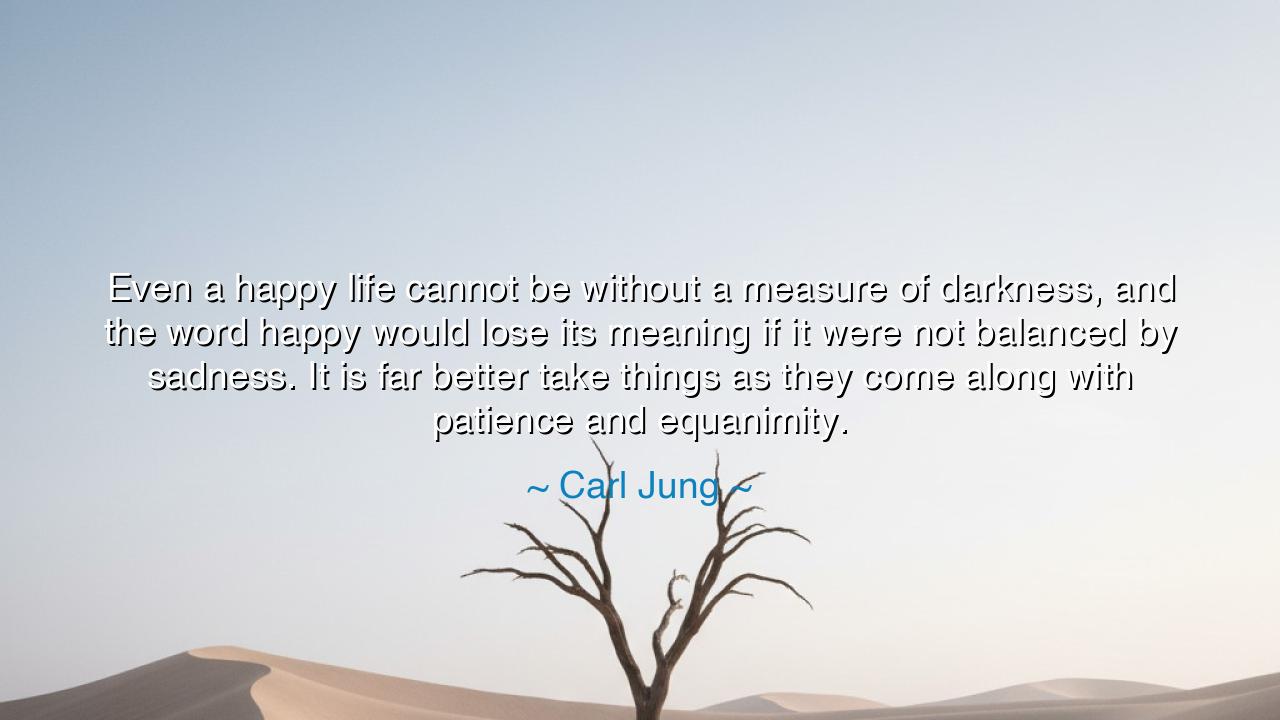
Even a happy life cannot be without a measure of darkness, and
Even a happy life cannot be without a measure of darkness, and the word happy would lose its meaning if it were not balanced by sadness. It is far better take things as they come along with patience and equanimity.






"Even a happy life cannot be without a measure of darkness, and the word happy would lose its meaning if it were not balanced by sadness. It is far better to take things as they come along with patience and equanimity." These words from Carl Jung speak to the inherent duality of the human experience—how joy and sorrow, light and dark, must coexist for us to truly understand and appreciate either one. Jung’s insight teaches us that happiness is not the absence of suffering, but rather, the ability to find peace and meaning even amidst life’s inevitable challenges. To experience true happiness, we must accept the reality of suffering as part of the whole of life. Without the contrast of sadness, the joys of life would lack depth, richness, and significance.
In the ancient world, philosophers and sages alike grappled with the relationship between pleasure and pain. Heraclitus, the great Greek philosopher, famously said, "The road up and the road down are the same." He understood that life’s contradictions are intertwined; to rise, one must first fall. His philosophy emphasized the impermanence of life and the interdependence of opposites. Likewise, the Buddhists teach the truth of suffering (Dukkha), acknowledging that pain is an intrinsic part of existence. Yet, they also offer the path to freedom from suffering, which lies in acceptance and equanimity—the very virtues Jung speaks of in his quote. Just as light cannot exist without darkness, so too, can our understanding of happiness not exist without the experience of sorrow.
Jung’s words resonate deeply in the context of human history. Consider the life of Nelson Mandela, whose long imprisonment and personal suffering became the crucible from which his greatest achievements were forged. For 27 years, Mandela endured the darkness of incarceration, a time filled with loneliness, pain, and hardship. Yet, it was through these very trials that his commitment to justice, equality, and reconciliation grew stronger. When he emerged from prison, his patience and equanimity allowed him to lead South Africa through a peaceful transition from apartheid to a democratic society. Mandela understood, as Jung did, that true happiness and freedom are not the absence of suffering, but the ability to overcome adversity with grace and courage. His life exemplifies the balance between darkness and light, showing how sadness can provide the depth needed to fully understand and appreciate joy.
The dual nature of existence is also found in the life of Frida Kahlo, whose art was born from both her immense suffering and her passionate joy. Kahlo’s life was marked by physical pain, stemming from a childhood accident that left her with lifelong injuries. Yet, despite these challenges, her paintings vibrated with vivid emotion, full of beauty, vulnerability, and resilience. Her works often explored the tension between life and death, pleasure and pain, capturing the full spectrum of the human experience. Kahlo’s art is a testament to how darkness and light coexist and how suffering, when embraced with courage, can give birth to some of the most powerful forms of expression and creativity.
Jung’s call to patience and equanimity is not a call to passive resignation, but to a mindful acceptance of life’s ups and downs. Patience is the ability to endure difficulties without losing one’s sense of purpose or balance. Equanimity is the inner peace that allows us to face both the joys and sorrows of life with calmness and clarity. The ancient stoics, such as Seneca and Marcus Aurelius, practiced a philosophy that embraced life’s challenges with stoic resolve. For them, the key to happiness was not in avoiding difficulty but in cultivating an inner strength that could weather any storm. Seneca, in his letters, taught that peace comes not from avoiding adversity but from facing it with the understanding that it is an inevitable part of the human experience.
The lesson here is profound: happiness is not a static, unchanging state, but a dynamic, evolving experience that includes both light and darkness. Joy and sorrow, success and failure, are not opposites but complements—each giving meaning to the other. Just as the sun needs the night to shine all the brighter, so too do we need the challenges of life to fully appreciate the moments of peace and happiness. To live fully is to embrace the full range of human experiences, to find growth in adversity, and to recognize the beauty in the impermanence of all things.
In our own lives, we must learn to accept both the joys and sorrows that come our way. When faced with challenges, we must practice patience and equanimity, knowing that peace and happiness will emerge not when we escape life’s struggles, but when we learn to face them with grace and strength. Just as Mandela and Kahlo showed us, suffering is not something to be feared, but a part of life that can lead to deeper understanding and authentic living. Let us embrace both the light and the darkness of our existence, knowing that it is through balance and acceptance that we will truly experience the fullness of life.






AAdministratorAdministrator
Welcome, honored guests. Please leave a comment, we will respond soon